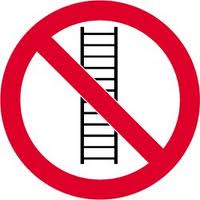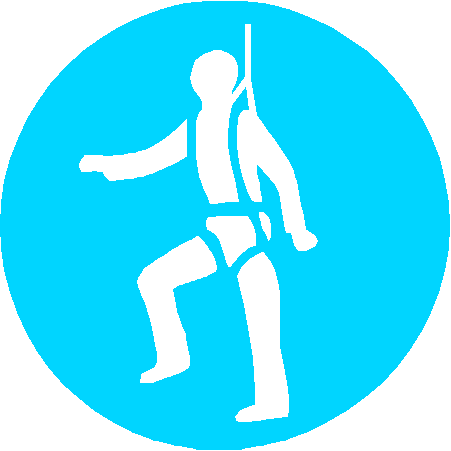You may be required to work at height in a variety of circumstances, whether in a port or dock, on board a vessel, at an airport, or at a trader’s premises or other unfamiliar location. The risks are the same and the necessary precautions must be taken. If you are not satisfied that you can work safely, then you should not do so until you are satisfied that appropriate equipment or precautions are in place.
1. What is work at height?
Work at height means work in any place where, if precautions were not taken, you could fall and injure yourself.
If you:
- work above ground level,
- could fall from an edge of a raised area (vehicle, container or cargo bay), or
- could fall from ground level into an opening in a floor or hole in the ground
- you will be working at height in any situation where you could fall from one level to another.
Examples of work at height include:
- gaining access to the loading area on a road or rail vehicle or container;
- working on top of a road or rail tanker, a vessel or container (to check inspection hatches);
- using ladders or stepladders to gain access to vessels, tanks, silos and storage bins;
- using working platforms such as scaffolds, tower scaffolds, cherry-pickers, scissor lifts and podium steps.
2. What precautions do I need to take?
Remember: work at height might be a one-off, or part of your routine. Make sure you identify all tasks which require work at height, so you can carry them out safely. The key to preventing injury if you have to work at height is to carry out a risk assessment, so you can take the right precautions.
Risk assessments and safe working practices should be maintained for all activities that involve working at heights.
3. Can you avoid working at height?
In some circumstances, it may be impossible to avoid working at height. However, cargo should always be examined and sampled in a suitable area. This usually means that the goods should be removed from the container or road vehicle and placed on the ground in a flat area, thus avoiding the need to work at height.
If you are working in an unfamiliar location or situation, you should consider the risks carefully and not proceed with the examination and sampling until you are sure it is safe to do so.
4. Can you prevent a fall?
 Yes, you can by:
Yes, you can by:
- using an existing workplace that is already safe, e.g. with permanent guard rails or a parapet around the edges, or a piece of plant or equipment that has fixed, permanent guard rails around it;
- using work equipment. If you cannot use an existing workplace, consider whether you can use work equipment to prevent people falling. Tower scaffolds, podium steps, cherry-pickers and scissor lifts are common examples of equipment which will serve this purpose, because the working platforms have guard rails.
Do not use improvised methods to gain access — such as a pallet on a fork-lift truck.
- If you need regular access, for example for inspecting the hatches on top of road or rail tankers, you should consider installing special access platforms.
When working on the top of road or rail tankers using the access fitted to the vehicle, always check that:
- the ladder is secure and any folding sections have been locked in place;
- the guard rails on the top have been raised and are secure;
- you have appropriate foot-ware. Remember if it is wet, frosty or there has been a spill, the metal surfaces may be especially slippery.
 Avoid using loose or unsupported ladders or stepladders where possible.
Avoid using loose or unsupported ladders or stepladders where possible.
- Temporary ladders should be secured at the top if possible or held at the bottom by a colleague.
- The ladder must be of a professional standard to take the weight of the person and any equipment.
- The ladder must be positioned securely and at the correct angle (this is often marked on the side of the ladder).
- If you cannot put measures in place to prevent a fall, you must try to limit the risk by minimising the height and/or consequences.
Consider carefully how you are going to carry sampling equipment and take the sample.
- When using ladders, you should always have three points of contact with the ladder. When climbing or descending you will need both hands free.
- Where access is by a ladder you must find a safe way of carrying your sampling tools and containers. This might be by using a back-pack or pulling them up on a rope after you have reached a safe platform.
- If it is necessary to take your sample whilst standing on a ladder rather than a platform you may be able to brace yourself with a knee or leaning your body against the ladder but it is preferable to use a harness attached to the ladder.
5. Can you minimise the consequences of a fall?
 You must first try to avoid and then prevent a fall before resorting to measures that will only minimise or limit the consequences.
You must first try to avoid and then prevent a fall before resorting to measures that will only minimise or limit the consequences.
- Safety nets are one example of such measures, because they should minimise the risk of injury if someone falls.
- A harness or fall arrest equipment will also minimise injury, but require special installation and training.
6. What other measures do you need to take to reduce the risk of a fall?
When using any equipment for work at height, you also need to make sure that:
- it complies with international standards or European norms;
- it is regularly inspected and well maintained;
- the people using it are trained to use it safely; and
- the work is supervised to check that people are working safely.
The normal use of ladders or step ladders does not provide measures which either prevent falls or minimise the consequences. So, you must be able to show that it was not reasonable to select alternative equipment because the task is low risk and short duration.
7. Have you identified whether there are any fragile surfaces?
You need to be particularly aware of any fragile materials in, or near, the area where you are working at height as they add to the risk. A fragile surface would be liable to break if anyone worked on it or fell onto it. Common examples include fibre and asbestos cement roof sheets and many skylights, but also bridged materials in silos.
Make sure that you:
- avoid the need to work on or near fragile surfaces or to cross them, e.g. by working from underneath using a tower scaffold or from above using a cherry-picker;
- prevent a fall by using fixed walkways with guard rails to cross a fragile asbestos cement roof or use suitable working platforms with guard rails when working on or near a fragile surface;
- minimise the consequences of a fall by using nets, airbags or fall arrest equipment.
8. Are there any other risks involved in working at heights?
Remember that working at heights can also add to other risks:
- Access equipment could bring you close to low roofs or other structures. Always check before using the equipment and wear head protection.
- Slipping hazards: Surfaces could be additionally hazardous because of water, ice or spilt materials.
- Tripping hazards: Access equipment could have cables, ropes or other tripping hazards attached to it.
- Electrocution: Access equipment could bring you close to overhead cables. Metal towers or other equipment must be kept well away from all overhead cables, regardless of the voltage or use.

 Yes, you can by:
Yes, you can by: Avoid using loose or unsupported ladders or stepladders where possible.
Avoid using loose or unsupported ladders or stepladders where possible. You must first try to avoid and then prevent a fall before resorting to measures that will only minimise or limit the consequences.
You must first try to avoid and then prevent a fall before resorting to measures that will only minimise or limit the consequences.